TechnologyMarch 30, 2021
TSN Technology Update: Impact on Automation

Time Sensitive Networking is changing the landscape of Industrial Ethernet protocols and network solutions with the possibility of new levels of convergence and interoperability. In this special report, industry experts weigh in on the benefits of TSN, what it offers and the expected timeline and impact on factory automation.
Time Sensitive Networking (TSN) technology offers tantalizing possibilities for the world of Industrial Ethernet automation and control networking. Never before have we seen enabling technology standards offer this kind of disruptive change, intermingled with the new requirements put into focus by the emergence of the IIoT and Industry 4.0.
The promise of Time Sensitive Networking (TSN) leveraging existing Industrial Ethernet network protocols, wireless TSN leveraging 5G communications, and technologies such as OPC UA TSN creates a preview of a new emerging landscape for industrial networks.
In this report, IEB offers comprehensive coverage and provides the perspective of industry leaders, along with a picture of how TSN is moving ahead in a quest that most agree will ultimately transform smart manufacturing. The broad range of perspectives demonstrates the potential of the technology, and illustrates how TSN will create new solutions for a wide range of applications.
Focus on converged networks
Expected emergence of IEC/IEEE 60802
The ability for TSN to help achieve a converged network architecture based on IEC/IEEE 60802 (TSN Industrial Automation profile) is a primary benefit that time-sensitive networking will bring to industrial automation applications. Along with that is delivering a plug & produce technology solution, as defined by Industrie 4.0, into the realm of smart manufacturing.
“The main innovation possible due to the availability of Time Sensitive Networks is the converged network,” Günter Steindl, Enterprise Architect at Siemens Digital Industries told IEB. “Thus, many automation companies like Siemens, ABB, Mitsubishi, Rockwell and others are started together the standardization of a TSN industrial automation profile as a joint IEC/IEEE 60802 project.”
Based on these definitions, devices with different middleware–such as PROFINET and OPC UA–can share in Time Sensitive Network quality of service guarantees. This converged network includes wireline and wireless, including Industrial 5G or Wi-Fi communication. Altogether, it represents the networking pillar “Vernetzung” from Industrie 4.0 and thus, fulfills the communication requirements of Plug & Produce.
Structured network design
According to Steindl, structured network design defining TSN Domains as areas of the industrial network, for production machines, production cells or production lines allow separation of concerns.
These converged networks provide a series of benefits for industrial communication:
- Scalability: machine to production line
- Provide guaranteed quality of service
- Protection of network resources
- Excellent network and connection diagnosis
- Support for splitting of application and communication
- Dynamic adaption – plug & produce
- Flexible network infrastructure – wireline and wireless with data rates from 10 Mbit/s to
- 10 Gbit/s; linear, star, ring, tree and hybrid topologies
- Scalable reliability from media redundancy to system redundancy
- Reliable and precise synchronization
Along with required quantities and flexible system architectures:
- Up to 1,000 devices
- Multiple PLCs
The IEC/IEEE 60802 (TSN Industrial Automation profile) selected features are used to solve the requirements for converged networks.
“Time-aware streams are the basis for zero congestion loss,” Steindl said. “Bridges and end station Ethernet interfaces configured by the TSN Domain Management Entity together with TSN Domain boundaries protect non-real time traffic. Quality of service guarantees for time-aware streams are ensured by end stations supporting time-aware network access and strict priority and preemption (IEEE 802.1AS, IEEE802.1Q, MEF 10.3, IEEE802.3) in the bridges.”
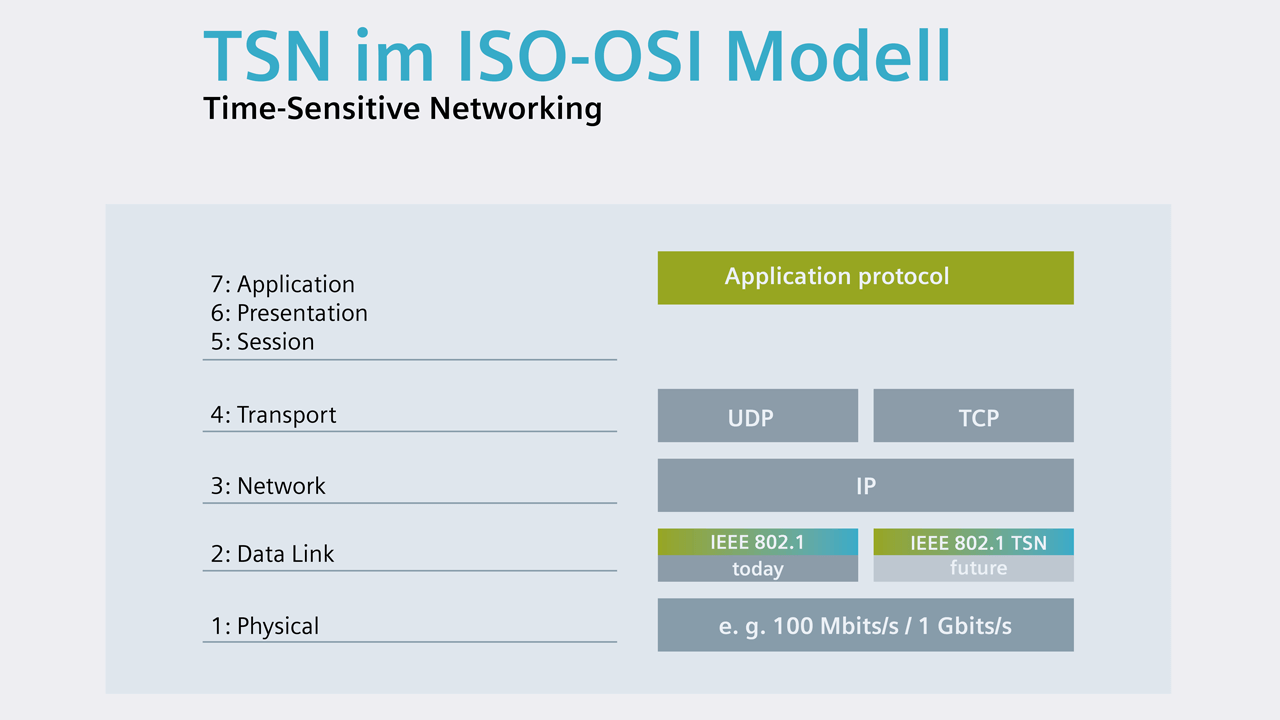
Time Sensitive Networking (TSN) in ISO-OSI model.
Middleware agnostic
He added that a main advantage of the TSN Industrial Automation profile is the possibility to create a converged network which is middleware (PROFINET, OPC UA, EtherNet/IP, CC-LINK) agnostic. The feature sets for Ethernet interfaces and bridges are defined, and silicon vendors can provide appropriate hardware.
“Almost all these new IEEE802 features are already available at PROFINET and thus, moving the ‘machine room’ of PROFINET to the TSN Industrial Automation profile is invisible for the PROFINET device developer. The customer of PROFINET over TSN devices will get the all the benefits of the converged network,” he added.
Steindl said that since the development and integration of this technology cannot be implemented in one single step, so a continuous and agile investigation of the technology, proof of concepts, first pilots and then products are a reasonable approach to the development process.
“Various developments are in different steps. We expect a broad acceptance because of the beneficial technology and the great market awareness,” he said.
The possible release of the TSN Industrial Automation profile is projected at the end of 2022, together with the specification of TSN over Industrial 5G, which will be a major push for this technology as well.
ODVA perspective on TSN
Impact on EtherNet/IP & CIP Motion
For users of EtherNet/IP and CIP Motion, the technology path to move forward with TSN is being shaped by the IEC/IEEE 60802 TSN Profile for industrial automation. This standard applied at the data link layer will allow for greater network coexistence at the application layer while maintaining network integrity.
Building on CIP Motion
According to Dr. Al Beydoun, President and Executive Director of ODVA, the EtherNet/IP communication network will be a critical enabler of Time Sensitive Networking within industrial automation. The significant number of EtherNet/IP installations globally will provide a strong starting point that will allow for existing capital investments and training to be leveraged. EtherNet/IP, aided by continuous specification enhancements, is already well-positioned to meet the needs of time sensitive applications, flexibility in network design, and Industry 4.0/IIoT with implementation of proper network segmentation.
“EtherNet/IP is designed to both move I/O traffic deterministically and quickly via low overhead UDP while at the same time allowing for more complex messaging to higher network levels including ERP systems and the cloud with TCP,” Beydoun told IEB. “EtherNet/IP will be uniquely positioned for the future with the addition of TSN, and will be able to both fully adhere to the mechanisms outlined in the IEC/IEEE 60802 TSN profile as well as the IEEE 1588 Precision Time Profile through CIP Sync and CIP Motion. CIP Sync is an existing network mechanism for applications where tight real-time synchronization is vital between distributed intelligent devices and systems.”
CIP Motion is a current deterministic network solution for multi-axis, distributed motion control. 60802 based TSN will serve as an additional layer of control and interoperability that EtherNet/IP users can take advantage of to enable network convergence with other types of Ethernet traffic, such as coexistence with cameras for high-speed scanning or security, while having all applications respect the same Quality of Service considerations.
IEEE 60802 TSN Profile
Beydoun said that the IEC/IEEE 60802 TSN Profile for Industrial Automation joint project will create one overarching implementation of TSN standards at the data link layer that will allow for increased network coexistence across the application layer while meeting the Quality of Service requirements of each industrial application.
The idea is that this will enable different industrial communication network traffic, including EtherNet/IP, to all co-exist on one deterministic network and respect the same Quality of Service considerations, with the addition of common time and common prioritization. Data packets with common headers and standardized priority levels will make this possible.
“Once finalized, 60802 will enable prioritization of time critical data on industrial networks, including EtherNet/IP, based on specific rules and methodologies that will be applied by 60802 compliant network switches and embedded switches,” Beydoun said. “Master time will need to be kept by specially designated TSN devices known as grandmaster clocks while other TSN devices will need to be capable of synchronizing with the master time clock. TSN uses 802.1AS-2020 which implements a peer-to-peer time delay mechanism, per the graphic below, and is a profile of the IEEE 1588 Precision Time Protocol. The CIP Sync protocol of today uses an end-to-end time delay mechanism and is the default profile in the IEEE 1588 Precision Time Protocol. Both CIP Sync and the 802.1AS time profiles are sufficiently precise, and can be converted to each-other via a dedicated device.”
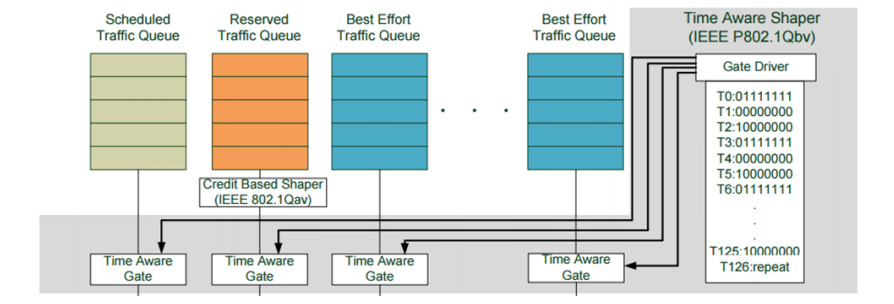
IEEE802.1 Qbv Queuing Structure.
Peer-to-Peer and End-to-End Clock
60802 based TSN is an additional solution that an EtherNet/IP network can employ to drive up utilization while minimizing the consequences of network traffic exceeding bandwidth limitations, which can cause issues due to delayed or lost message packets.
60802 based TSN provides a further option for flexibility in EtherNet/IP network design that makes it possible for I/O devices demanding high determinism and video cameras that transmit large amounts of data to coexist on the same network, as an example. This is possible through prioritization of data that takes place within Ethernet bridges in different ways based on user commissioning. The IEEE 802.1Qbv Queuing Structure creates solutions for TSN prioritization using some of the following key prioritization mechanisms:
Shapers: Such as strict priority Quality of Service and the credit-based shaper. These algorithms give precedence to high priority traffic and ensure fairness on the wire. While these mechanisms are not new, the shared language to configure them is.
Preemption: Pauses an existing packet transmission to allow higher priority data through.
Scheduled Traffic: The ability to control transmission of traffic based on enabling and disabling switch queues on a configured time-based schedule.
IEEE 802.1Qbv Queuing Structure
According to Beydoun, industrial networks are now facing the impending addition of large amounts of data from the factory floor to edge devices and/or the cloud and back regularly for system analysis and prognostic purposes due to Industry 4.0 and IIoT.
The 60802 profile of TSN standards for sending time critical data via industrial Ethernet, along with existing EtherNet/IP network extensions, are a pragmatic way to meet the needs of high determinism applications, to add network design options, and to plan for the significant future increases in data traffic brought about by IT and OT convergence.
“EtherNet/IP will continue to meet critical industrial communication and control needs into the future, including coexistence with other protocols and a performance guarantee for highly-engineered applications with TSN,” Beydoun said.
ODVA’s members are currently contributing to the IEC/IEEE 60802 TSN Profile for Industrial Automation joint project that is selecting the TSN mechanisms that will be used and determining how they will be used. This work will likely be completed in late 2022 to 2023.
ODVA anticipates that the changes necessary for the EtherNet/IP specification will be minor and backwards compatible because EtherNet/IP was designed using the standard Ethernet data-link layer and the standard IETF defined IP/TCP/UDP layers above it. ODVA’s publication of EtherNet/IP enhancements to incorporate TSN will be coordinated with the publication of the 60802 TSN Profile to ensure a stable standard.
TSN-compatible protocols
Industrial Ethernet protocol compatibility
According to ChihHong Lin, Global Technology Partner Manager at Moxa Inc., industrial networking and control suppliers have responded to TSN with the development of compatible industrial Ethernet protocols.
“Since the dawn of TSN technology, major industrial Ethernet protocol organizations have begun actively formulating standards and developing TSN-compatible industrial Ethernet protocols,” Lin said. “Take these organizations for instance: the CC-Link Partner Association (CLPA), the PROFIBUS & PROFINET International (PI) organization, the OPC UA FLC initiative launched by the OPC Foundation, and EtherNet/IP–an industrial Ethernet protocol developed by ODVA. This allows users of different industrial Ethernet protocol ecosystems to take full advantage of the latest TSN technology.”
In 2018, the CLPA completed and issued the “CC-Link IE TSN” specification based on the TSN standard. A subsequent CLPA white paper described several application cases such as an automotive paint shop and semiconductor processing tools, illustrating the practical advantages of a unified network using the CC-Link IE TSN protocol.
As of September 2020, the CLPA has more than 300 corporate members, with several manufacturers having released products compatible with the CC-Link IE TSN standard. Moxa has a lineup of Layer 2 Ethernet switches that are compatible with the Class A and Class B CC-Link IE TSN Standard.
Deterministic performance
Lin said that TSN is a collection of standards that enables deterministic messaging over standard Ethernet networks. As defined by the Institute of Electrical and Electronics Engineers (IEEE), TSN involves a form of network traffic management to ensure non-negotiable time frames for end-to-end transmission latencies.
Consequently, all TSN devices must synchronize their clocks with each other and use a common time reference to support real-time communications for industrial control applications. In general, TSN technology can be introduced as four parts:
Time Synchronization: As the name suggests, time-sensitive networking focuses on establishing a common time reference between all devices within a unified and interoperable infrastructure, which forms the foundation of its entire operations.
Bounded Low Latency: By adopting the concept of non-negotiable time period allocation for end-to-end transmissions, these components ensure deterministic data transmission over the network.
Ultra-reliability: To implement and maintain all aspects of a deterministic networking environment, a set of components has been defined to ensure optimal reliability and security.
Resource Management: When the network and applications become more converged and larger in scale, additional tools are required to provide better manageability and visibility.
One unified network
“One of the major benefits of TSN is that it can turn a complex network infrastructure into one unified network,” Lin said. “For the time being, your organization may be satisfied with production output. However, in the long term, you will find it difficult to keep up with your competitors as they embrace TSN technologies. On the one hand, you can still expand your production based on the existing infrastructure, but the expansion will be stretched to the limit when you find, for instance, the conveyor belt is communicating with the HMI by PROFINET. On the other hand, the motion control that requires hard real-time is using EtherCAT, and the robotic arm control is using another protocol, for example, Mitsubishi CC-Link IE.”
He added that, even though it is comparatively easy to make use of add-on blocks as you deem necessary, managing all of these devices from different vendors who utilize different industrial Ethernet technologies is very difficult. When each cell is isolated, there are many obstacles to just integrating the data, not to mention if you want to fine tune the processes and improve production efficiency.
In the long term, the result will see you moving in the opposite direction of realizing Industry 4.0 and IIoT applications. More importantly, TSN technology also allows for a plug-and-produce solution when extra applications such as machine vision and motion cameras are added onto one unified network.
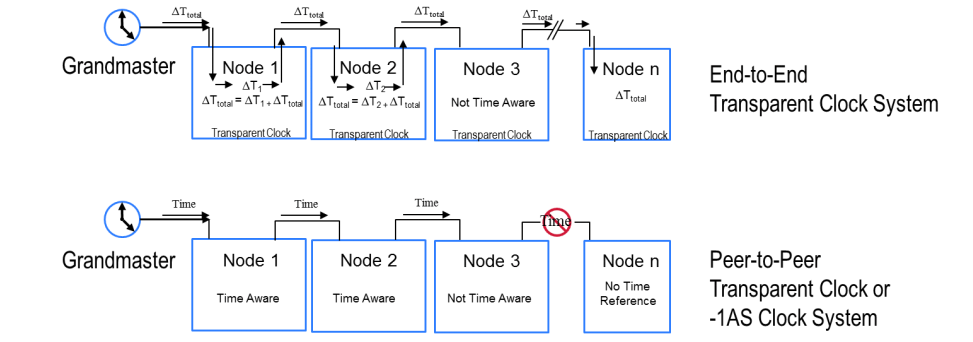
System diagrams showing end-to-end transparent clock versus peer-to-peer.
Impact of TSN technology
“The automation industry has long been looking forward to the possibility of a unified network that can address the challenges many factories face today. This is where time-sensitive networking (TSN) technology comes into play,” Lin said. “Based on standard Ethernet, TSN can achieve network-wide time synchronization, lower latency, higher reliability, and optimized management along with support for industrial Ethernet protocols.”
With these enhancements, TSN effectively solves the complications of IT and OT convergence, breaking through the islands of automation to realize the future imagined by smart manufacturing. One unified network includes the following benefits:
- A single industry standard used for communication.
- Minimal training effort to understand different vendor’s protocols
- Reduced cabling and maintenance costs
Therefore, the plug-and-produce solution can actually be achieved.
“Regarding the timeline, we have seen the completeness of the TSN ecosystem from PLCs, IO, drives, servo, Ethernet switches, IPC, to software-based controllers,” Lin concluded.
“Throughout 2020, the industry players who have started to utilize TSN technologies have demonstrated to the world that TSN is not just an embryonic idea, but a concrete technology through multiple virtual demonstrations. In 2021, we foresee that there will be pioneering TSN cases landing in smart manufacturing.”
Data link layer innovations
CC-Link IE TSN leverages enabling technologies
As TSN emerges as an enabling technology that will help fulfill the vision of a converged network, time-sensitive networking standards are primarily focused on updates to the Data Link Layer of the Open Systems Interconnection (OSI) model.
“It’s important to note what TSN can and cannot do. It is a modification of the standards related to the Data Link Layer (Layer 2) of the OSI hierarchy. It is primarily concerned with getting ‘1’s and ‘0’s from one place to another in a predictable, deterministic manner,” said John Browett, General Manager at CLPA Europe. “For this reason, it does not address higher level application functions, such as safety or motion control. We believe that the best TSN implementations will combine its deterministic capabilities with higher level protocols that will provide these additional application functions.”
Browett said that CC-Link IE TSN is an example of how a familiar, existing industrial Ethernet protocol can be extended to be TSN-compatible and therefore address these needs.
“It provides a way to handle current demands while providing a path to address future requirements. This is being supported by key members of the CLPA such as Mitsubishi Electric who have already introduced a varied line-up of products that offer TSN capabilities,” Browett added. “These will enable capabilities like high performance motion control to be combined with other application needs such as safety to provide a flat hierarchy that addresses today’s needs with the route to the future that TSN offers.”
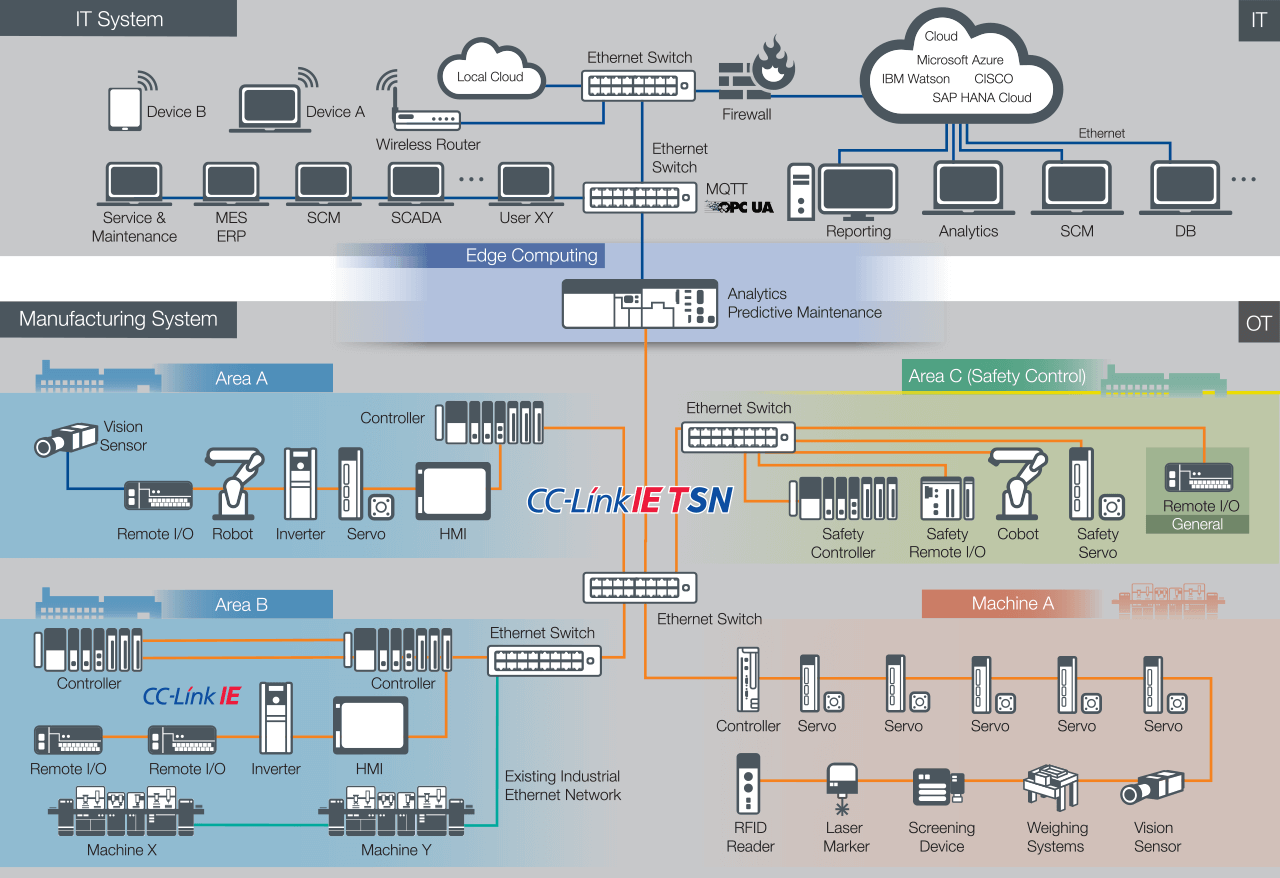
A converged network architecture using CC-Link IE TSN provides an approach to unify manufacturing and enterprise data.
CC-Link IE TSN
The key for CC-Link IE TSN is its ability to extend the existing technology of CC-Link IE and, as its name suggests, combines it with TSN compatibility. CLPA also says that CC-Link IE TSN solution is currently the only open industrial Ethernet that combines TSN with gigabit Ethernet.
TSN technology advances are based on two core IEEE standards, 802.1AS and 801.1Qbv, which provide a way for Ethernet traffic to travel in a deterministic manner. 802.1AS synchronizes all network devices, preventing drifting that leads to delays and variation in transmission (latency and jitter), enabling deterministic data transfer. 802.1AS Qbv defines queues of different traffic types and controls their access to the network. This permits prioritization of what traffic can travel when, further supporting determinism.
“Gigabit bandwidth increases the overall network traffic capacity. Once thought to be ‘overkill’ in industrial automation, there is now a clear trend in this direction. It is being driven by Industry 4.0, which is causing a clear increase in the amount of process data,” Browett added.
“The idea is to provide better transparency and hence improved process management. For this to happen, the data needs to be processed in a timely manner in order for actionable insights to be generated. This is why network bandwidth is also becoming a key concern.”
TSN technology benefits
Compared with typical applications today, the adoption of TSN will bring forward specific technical benefits that will have a lasting impact on industrial automation.
“The key benefit is converged networks. Today, some industrial Ethernet protocols allow multiple types of application data (often I/O, motion and safety) to share a network. However, usually it is not easy or even possible to have this traffic run alongside other types, for example machine vision video frames, barcode scanner data, print outs, etc. on the same network,” Browett said.
Usually, separate networks are necessary to handle different tasks. This increases cost, complexity, engineering time and maintenance.
TSN allows virtually any kind of Ethernet traffic to share a network. Hence one network should be able to address all application needs. The promise is that this approach will deliver cost savings and performance benefits by removing multiple networks running parallel functions.
By running all traffic together, increased process transparency is also enabled. If the data all flows together, collecting and processing data from multiple different places and systems can be avoided and it becomes easier to understand what the process is doing and therefore manage it better. It will also potentially avoid “islands” of data where incompatible systems cannot talk to each other, as TSN offers the chance for different industrial Ethernet protocols to also run on the same network and further increase transparency.
Looking ahead
The benefits of TSN will come from network convergence, and its ability to deliver the process transparency demanded by Industry 4.0.
The expectation is that it will also become easier to get data to edge servers and the cloud for processing and insight. Smart manufacturing takes the manufacturing data, and processes it in various ways to produce actionable information. TSN will enable this by getting the data where it needs to be in easier, timelier ways.
“TSN is already here. We introduced CC-Link IE TSN in 2018, and since that time our partners such as Mitsubishi Electric introduced various compatible products. We are also seeing various plans to support TSN by other players. It’s not a question of if, but when,” Browett said. He added that TSN is probably in a similar stage to where Industry 4.0 was about five years ago.
“Everyone understood the benefits and early implementations were underway. Possibly two to three years from now, TSN will be as commonplace as general industrial Ethernet is today, which may begin to be viewed with the same legacy status as fieldbuses. Hence for companies looking for a competitive edge, there is a narrow window of opportunity to start implementing TSN before it becomes commonplace and the chance to get ahead is lost!”
Next generation architectures
Traffic co-exists on a single Ethernet network
According to Bastian Otto, Product Management at Hilscher Gesellschaft für Systemautomation mbH, TSN is not a product or a protocol, but a series of standard Ethernet extensions, defined by the IEEE, in support of next-generation automation architectures.
It is based on the concept of common time domains within which a variety of automation components from different vendors (in theory anything from simple sensors up to multiple PLC combinations) can co-operate in time sensitive environments.
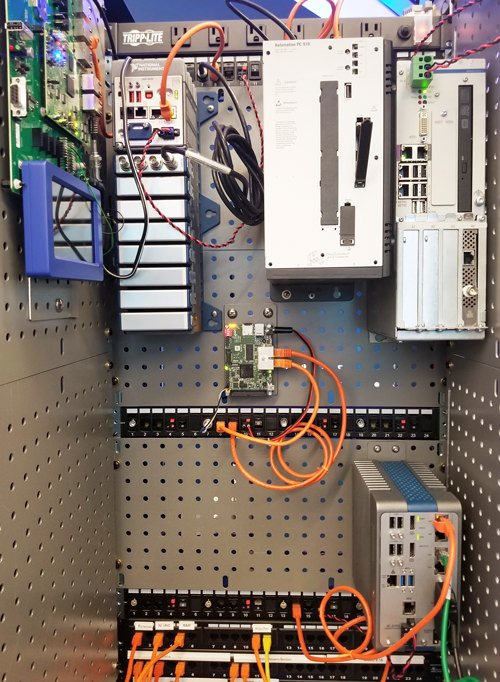
This IIC Testbed Demonstrator in Austin, Texas, shows multi-vendor products that were “plug-and-play” tested for interoperability of TSN synchronization. At center is a Hilscher netX chip-based board.
The concept will allow many different types of data traffic to co-exist on a single Ethernet network, and enable clusters of control and monitoring components to work together to create smarter manufacturing units. This demands sophisticated time synchronization AND prioritisation mechanisms.
“The emerging TSN solution is based on a toolset of multiple OSI Layer 2 standards that describe how existing Real-time Ethernet protocols can be extended to meet the required behaviours,” Otto said. “They cover only the data transport layer but they can meet a very wide spectrum of use cases. No installation will deploy all the standards at once, so “use cases” will determine the roll out. The introduction of TSN will therefore depend on ‘profiles’ – collections of features taken from some or all the standards to meet a particular need. The first of these, a real-time “machine-to-machine” profile, is currently being finalized. A ‘controller-to-device’ profile is expected thereafter.”
How TSN is transformational
Otto said that the ability to support multi-PLC configurations carrying status, configuration, control, video, audio, and motion control data over the same media is the starting point.
Gigabit Ethernet will make far more data available than is possible today and, with higher speed and more reserved bandwidth, will allow the transmission of more real-time protocols over the same wire. This will lead to new production control, asset management and preventive maintenance regimes being introduced, particularly when edge and cloud computing concepts are included. TSN will only allow raw data to be exchanged.
Therefore, higher level application layer differences will remain. However, multiple PLC structures will be able to co-exist within a TSN domain and inter-communicate successfully when the same protocol is supported.
“TSN will lead to new control regimes being developed, particularly in the context of flexible manufacturing. Real-time machine-to-machine communications will be possible and having a combination of PLCs in one TSN domain will lead to ‘virtual PLCs.’ The current hierarchical ‘pyramid’ structure will disappear and be replaced by a pillar-like architecture in which remote control of actuators and sensors becomes possible. The goal of truly flexible manufacturing down to one-offs comes into view, and a merging of the traditional ‘pyramid’ layers, such as ERP and MES, is certain to occur,” he added.
Replacing Ethernet protocols
At the start of the TSN standardization process, many expectations were raised, including the possibility that TSN would replace existing Industrial Ethernet standards. Niels Trapp, Vice President Business Development, Hilscher Gesellschaft für Systemautomation mbH told IEB that this will not happen based on the explanations above.
Some of the TSN sub-standards are still under development and there will be updates arising from experience in the field,” Trapp stated. “Driven by the industrial automation industry, the deployment of TSN will lead the adoption of new control concepts. The machine-to-machine profile will have an early impact, especially in greenfield applications. I can also see brownfield applications being possible. As industries move towards greater TSN usage, controller-to-controller networking will be deployed. In other words, the adoption of TSN will be an evolutionary process that will lead to controller architectures being fundamentally altered.”
He added that the problem presented by raw data only being available via TSN networks will lead to new meta-data mechanisms being developed, and OPC UA (in its pub/sub incarnation) is one way the semantic challenges can be met.
5G will also play a role: release 16 of the 5G standard will improve latency so that TSN routing over wireless systems should eventually be realized. However, we should understand that it will be challenging to merge OPC UA into field devices.
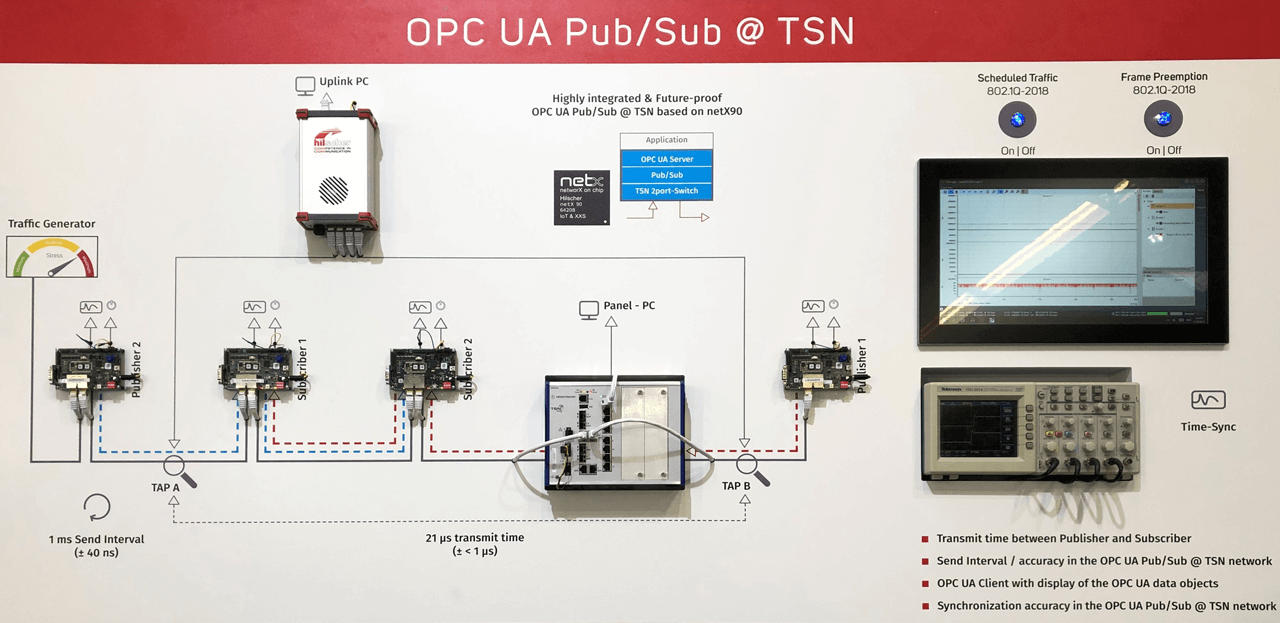
At the most recent SPS Fair in Nuremberg (pre-pandemic), Hilscher demonstrated its netX 90 slave communications chip running OPC UA Pub/Sub data
Challenges to TSN adoption
According to Trapp, Hilscher expects TSN will become a standard in controller interfacing based on Gigabit Ethernet to allow clustering of control units. This will enable highly distributed systems operating transparently from the field right up to the cloud. But he adds that we must be realistic about the huge challenges involved.
“Wider roll-out of TSN may begin in 2022, but I believe that TSN will not see widespread uptake for some while. Several issues will need to be resolved, including: the actual speed of standardization, security at the field level, and trends encompassing the use of data pre-processing within field devices themselves.”
He said that real-time Ethernet protocols such as PROFINET and EtherNet/IP, both comparable disrupting technologies, took many years to become widely used. But the disruption that TSN will bring has already started and engineers everywhere should “get involved” now.
There are many opportunities for learning, and RTE organizations have all announced TSN support. Many companies have launched TSN “compatible” products. Hilscher has been demonstrating TSN systems at trade fairs for more than three years based on its own netX chips, which are software-configurable and therefore easily adapted to any changes in the TSN specifications.
OPC UA over TSN
Open standard emphasizes interoperability
The promise of Time-Sensitive Networking and OPC UA over TSN specifically, is focused on two areas: an increased use of open standards that ultimately leads to a new level of interoperability on industrial networks.
“For TTTech Industrial, openness and interoperability are the key components of IIoT. In our solutions, we use TSN and OPC UA in combination, because both are standardized by international organizations and thus vendor-independent,” Wolfgang Leindecker, Member of the Executive Board at TTTech Industrial, told IEB.
“This is a decisive factor as no two customers are the same and therefore have very specific requirements for implementation of IIoT on their shop floor.”
Leindecker said that, with OPC UA over TSN, users have a range of products to choose from and they can combine them to best fit with their individual situation. Open interfaces allow guaranteed communication and message delivery between devices from different vendors and also extend to device configuration and network planning interaction.
Thanks to this, customers can reduce initial commissioning effort and they have more flexibility in system extension and reconfiguration.
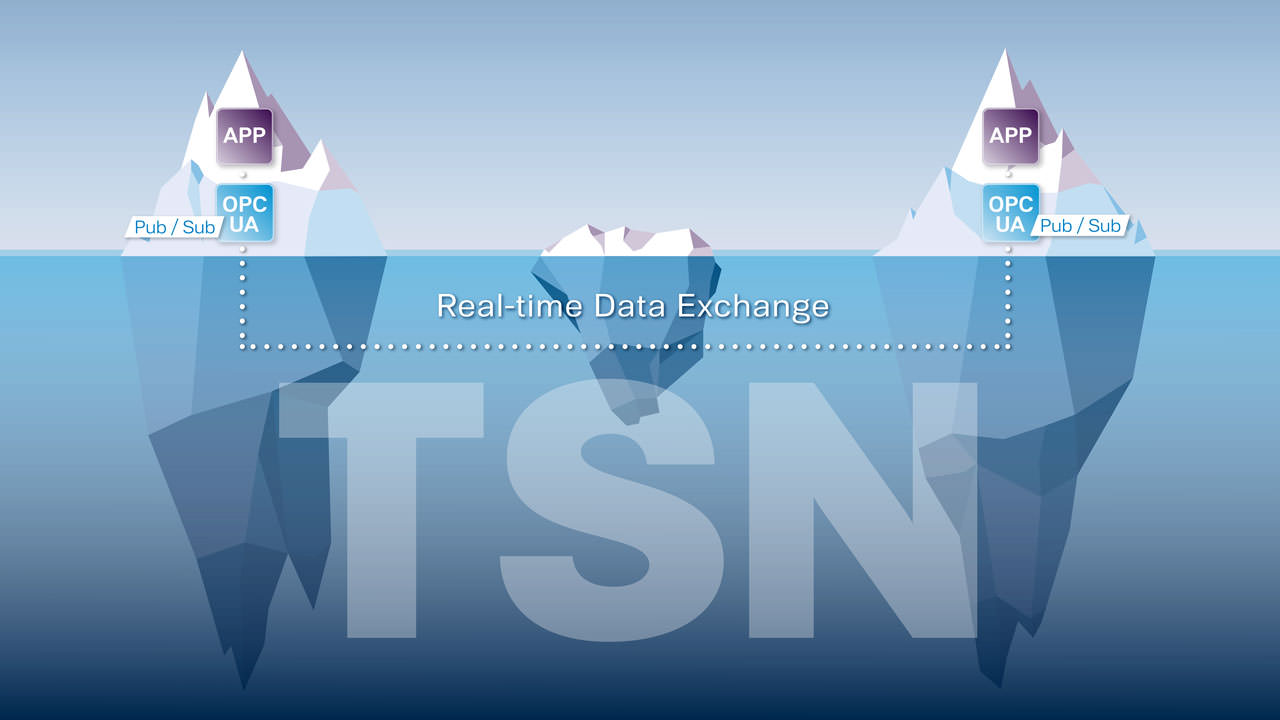
OPC UA over TSN offers guaranteed and interoperable communication for industrial automation. TTTech Industrial’s Slate product line includes TSN switched endpoint IP and software, along with advanced network planning tools.
Two sets of standards
OPC UA over TSN makes use of two sets of standards. TSN, which is a group of mechanisms that enable precise timing and guaranteed delivery of messages and OPC UA, which is a widely used protocol allowing data to be modeled and exchanged in a standard format.
“When OPC UA devices publish data over TSN networks it can be received by OPC UA subscribers in the network. TSN devices in the network forward messages according to a plan, ensuring that published OPC UA data is received in a predictable way and with low latency,” Leindecker added. “TTTech Industrial also uses OPC UA as a means of gathering device requirements in order to build products that offer automated and dynamic configuration of TSN networks. “
IT-OT convergence
According to Leindecker, OPC UA over TSN brings the flexibility and interoperability from IT into the OT world. One of the main benefits is a standardized information model that enriches raw data with semantic descriptions, offering immediate context to data without the need for interpretation. This contrasts with today’s proprietary fieldbuses, which primarily deliver raw data that is unreadable by devices from different vendors.
Along with TSN, this provides a fully interoperable method of sharing data between any industrial devices. Inherent to OPC UA are also a range of sophisticated IT security mechanisms that go beyond the level of security that OT networks can offer today. Implementing IT grade security methods such as user authentication and authorization, encryption and certificate handling to OT networks will further accelerate the convergence of IT and OT systems. That convergence will improve data access by providing connectivity from sensor to cloud without the need for gateways.
Emergence of TSN technology
When asked about the expected impact that TSN will have on smart manufacturing, and the general timeline for these innovations, Leindecker sees a long-term emergence of the technology.
“It is difficult to give a precise timeline. Chip makers and industrial automation vendors are already releasing TSN products so now is the time for integration projects to pioneer TSN networked production lines and factories,” Leindecker said. “In the next years, we will see fully smart factories that use TSN as a backbone network connecting cells, machines and devices from various industrial automation vendors in a way that would previously have been unthinkable. These end users will reap the benefits of greater efficiency and costs savings provided by TSN.”
TSN and 5G
Potential focus on new applications
According to Paul Brooks, technology manager – business development at Rockwell Automation, he believes it makes sense for customers to start with a focus on potentially implementing TSN in applications that can’t be solved today using available technology—and where users have real need.
One obvious application area would be coordinating motion control across a wireless link to leverage the capabilities of TSN and 5G.
“If the combination of TSN and 5G actually helps organizations, then this will drive adoption,” Brooks told IEB recently. “Whether or not TSN and 5G proves to be a practicable solution, however, remains to be seen.
“Today, users have to segment different industrial automation protocols like EtherNet/IP and Sercos onto separate network segments. So, if TSN makes it easier to converge these technologies onto a single network, it would help users overcome a key challenge associated with today’s industrial network architectures,” he added.
Brooks added that OPC UA FX (Field Exchange) is what he views as the most likely technology to drive this convergence, as all ecosystems are supporting its development. And if TSN simplifies users’ deployments of UA FX technologies, then TSN becomes an easy decision.
“But it’s far too early, with respect to standards development, to talk with any certainty about TSN. Without an agreed and published common profile of TSN for Industrial Automation (IEEE/IEC 60802), none of the capabilities mentioned above can be realized,” he said.
Network management tools
One interesting technology area is how TSN provides network management to ensure that the most time-critical packets get delivered within a guaranteed transmission window. To do this, all the TSN devices and infrastructure agree in advance about when to transmit these packets. This makes certain that there are no obstacles (lower-priority packets) in the way before transmission.
Brooks said that key technologies that make these TSN capabilities possible include a common time reference, shared by devices and switches, and packet (stream) scheduling which reveals when critical packets will be on the wire, along with cut-through to speed packets through the network.
Preemption features also keep big packets from getting in the way of time-critical packets. And topology discovery creates an ability to plan the path that packets will take through the network. A fundamental challenge, however, is that TSN is really “these technologies” rather than “this technology.” The result is that many different stakeholders (and many different systems in the field) will have to implement TSN in different ways.
“At this moment early in 2021, we simply don’t know which of the component technologies will ultimately be carried forward to IEEE/IEC 60802,” Brooks added, “nd which will be used by communications protocols like OPC UA FX. So, for now, making any meaningful plans for TSN is all but impossible.”
Keys to TSN adoption
Specific technical benefits that the technology provides will enable early adoption of TSN, versus what is possible with typical applications today.
“The real key to the adoption of TSN will be the availability of good software tools. TSN will live or die by the software tools that are delivered by vendors. TSN provides tool vendors with a set of services that allow software tools to replace engineers, and for network designs to be less bounded,” Brooks said.
“But these software tools must be easy to use in a heterogeneous network that combines IT and OT equipment—from multiple vendors using multiple technologies. If the tools aren’t easy to use, however interesting the technology might be, widespread adoption (of TSN) won’t happen.”
He added that most new applications today can be solved with standard, unmodified Ethernet. But the catch is that, for more challenging applications, users need highly qualified engineers to design the system and also need to be working within bounded design recommendations such as Rockwell Automation’s Converged Plantwide Ethernet Reference Architecture, for example.
TSN impact and timeline
When asked about the impact that TSN technology will have on smart manufacturing and the general timeline for innovations, Brooks cited TSN’s strengths and how it operates with the network architecture.
According to Brooks, TSN helps protect time-critical motion traffic from the increased traffic volume brought about by smart manufacturing. But smart manufacturing actually happens at a higher layer, at the Application layer, of the technology stack. It’s a reminder that TSN operates down at Layer 2 of the OSI network model.
“Smart manufacturing is fundamentally about IIoT; it is this merging of OT and IT that results in increasing non-time-critical (IT) network traffic—across the same wire,” Brooks said. “This is where TSN comes in, creating new standards for Ethernet such that it can become deterministic by default, and support motion control.”
In a more standardized way than today’s installed Industrial Ethernet implementations, he notes that TSN has an important role to play in smart manufacturing, but that role must not be overstated. Other technologies are more important; today’s users will do best by starting the journey to the Connected Enterprise. Within the Connected Enterprise, smart manufacturing empowers flexibility and reconfiguration of machines.
“TSN is an enabling technology, providing a protected boundary within a machine, so that it can operate predictably wherever that machine is located in the wider network,” he added. “But smart manufacturing is in the cloud, while TSN operates narrowly within a production cell—with limited relevance to the broader enterprise.”
Al Presher, Editor, Industrial Ethernet Book

5G combined with TSN for industrial communications
The integration of 5g and TSN could be an important future step to make smart factories more fully connected, and able to meet all key requirements for more effective industrial communication technology.
Learn More
Q&A on TSN technology
Martin Rostan, Executive Director of the EtherCAT Technology Group, provides perspectives on the development and roll-out of TSN technologies and its impact on EtherCAT solutions.
Learn More

